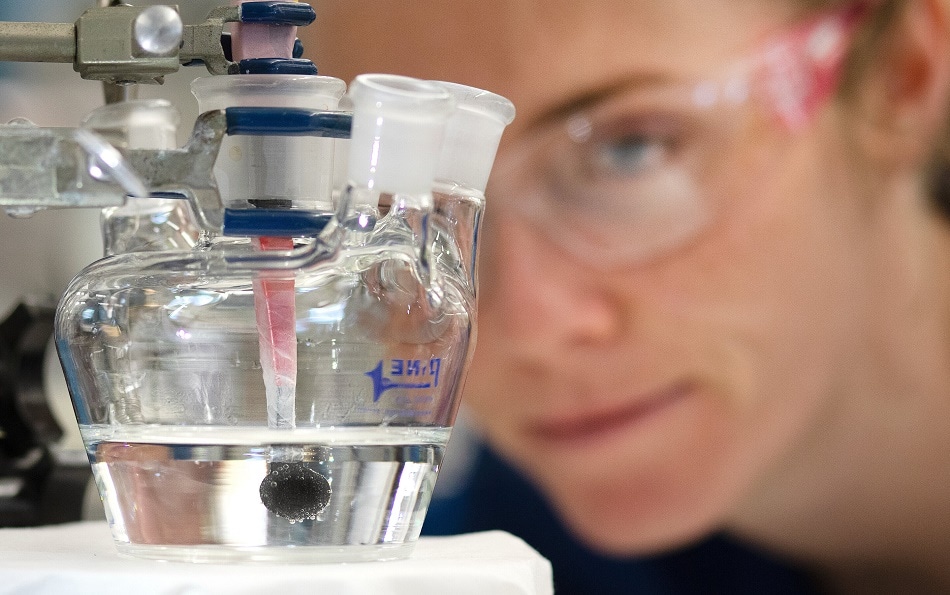 Stanford graduate student McKenzie Hubert watches a catalyst produce bubbles of hydrogen in a small, lab-scale electrolyzer. The catalyst, cobalt phosphide, is a lot cheaper than the platinum catalyst used today and could help reduce the cost of a process for making hydrogen on a large scale with clean, renewable energy. Image credit: Jacqueline Orrell/SLAC National Accelerator Laboratory
Stanford graduate student McKenzie Hubert watches a catalyst produce bubbles of hydrogen in a small, lab-scale electrolyzer. The catalyst, cobalt phosphide, is a lot cheaper than the platinum catalyst used today and could help reduce the cost of a process for making hydrogen on a large scale with clean, renewable energy. Image credit: Jacqueline Orrell/SLAC National Accelerator Laboratory
Generating hydrogen gas in commercial devices for industry whilst maintaining clean energy supplies can be a costly endeavor. Research and development has taken place over a number of years to replace precious metal catalysts in polymer electrolyte membrane (PEM) technology.
Now, a collaborative team effort between the Department of Energy’s SLAC National Accelerator Laboratory and Stanford University demonstrates how a cheap new catalyst has the ability to split water and produce hydrogen for hours at a time.
This pioneering approach could usher in an age of zero emissions travel and power generation as well as providing a clean energy boost to industries such as agriculture and metal refining. The cheap new catalyst makes use of electrolyzer technology, based on previous PEM processes which has previously been inhibited by high-costs incurred when using precious metals such as platinum and iridium. This study, published in Nature, illustrates an evolution for non-precious hydrogen catalysts and the potential for commercial applications.
“Hydrogen gas is a massively important industrial chemical for making fuel and fertilizer, among other things,” said Professor Thomas Jaramillo, director of the SUNCAT Center for Interface Science and Catalysis at Stanford, who led the research team.
However, Jaramillo argues for hydrogen as a “clean high-energy-content molecule”, methods of producing the gas make use of fossil fuels increasing CO2 levels in the environment. “We need a cost-effective way to produce it with clean energy,” he stated.
The electrolyzer device utilized by Jaramillo and his team was made by a PEM electrolysis research site in Connecticut for Nel Hydrogen, the oldest dedicated hydrogen company founded in 1927. The development of the electrolyzer was funded by the Defense Department who is interested in the oxygen generating side of the process for submarines.
The device operates by putting water into the system which then reacts to generate positively charged hydrogen ions and oxygen gas. These ions then move across a membrane as electrons circulate externally and meet the hydrogen ions at the cathode to combine and form hydrogen gas with the aid of a catalyst.
The Nel Hydrogen team inserted the new cheaper catalyst produced by the SLAC and Stanford researchers. The catalyst is a fine black powder made up of cobalt phosphide nanoparticles layered onto carbon. It acts in the same way more precious metal catalysts do by encouraging rapid chemical reactions in elements.
“Our group has been studying this catalyst and related materials for a while,” said McKenzie Hubert, a Stanford University Graduate Student and part of Jaramillo’s team. “We took it from a fundamental lab-scale, experimental stage through testing it under industrial operating conditions, where you need to cover a much larger surface area with the catalyst, and it has to function under much more challenging conditions.”
The new cobalt phosphide catalyst displayed an ability to perform throughout the entire duration of the experiments which exceeded 1,700 hours. This promising statistic could mean that the catalyst is close to being used in everyday applications at elevated pressures, temperatures, and increased conditions of acidity. This meant that the study placed a certain emphasis on the scaling up of production of the catalyst while maintaining a uniform structure.
In order for the team to generate a catalyst that was stable and uniform when scaled up they synthesized the material using a pestle and mortar before placing the powder into a furnace. Thus, the team was able to produce a kind of ink that could be deposited onto paper sheets of porous carbon.
The performance of the cobalt phosphide catalyst needs to get a little bit better, and its synthesis would need to be scaled up. But I was quite surprised at how stable these materials were. Even though their efficiency in generating hydrogen was lower than platinum’s, it was constant. A lot of things would degrade in that environment.
Katherine Ayers, Vice-President for Research and Development at Nel and Co-Author of the paper
Due the platinum market being in an uncertain state at the moment due to the prices of the metal in a constant state of flux generating hydrogen with PEM using precious metals hinders the R&D of the technology. Therefore, the study conducted by SLAC and Stanford marks a significant leap in progress towards the realization of a future in which producing clean-energy hydrogen is both realistic and cost-effective. Jaramillo stated that the study, “meets the goals of the H2@Scale initiative”, which brings DOE labs and industry together to develop affordable transport, production, storage, and use of hydrogen.
Disclaimer: The views expressed here are those of the author expressed in their private capacity and do not necessarily represent the views of AZoM.com Limited T/A AZoNetwork the owner and operator of this website. This disclaimer forms part of the Terms and conditions of use of this website.